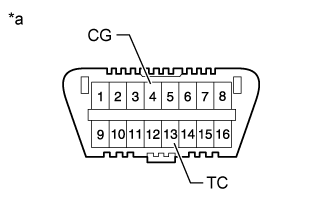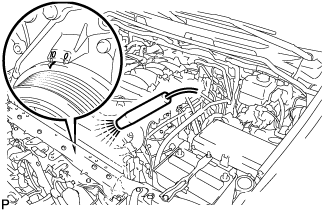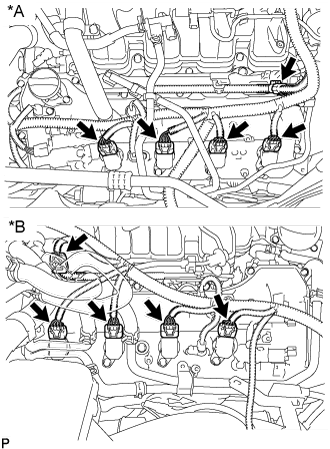Land Cruiser URJ200 URJ202 GRJ200 VDJ200 - 3UR-FE ENGINE MECHANICAL
ENGINE - ON-VEHICLE INSPECTION
| 1. INSPECT IGNITION TIMING |
Warm up and stop the engine.
Allow the engine to warm up to a normal operating temperature.
When using the intelligent tester:
Connect the intelligent tester to the DLC3.
Start the engine and idle it.
Turn the intelligent tester on.
Enter the following menus: Powertrain / Engine and ECT / Data List / Primary / IGN Advance.
- HINT:
- Refer to the intelligent tester operator's manual for further details.
- Standard ignition timing:
- 8 to 12° BTDC @ idling (transmission in neutral and A/C switch off)
Disconnect the intelligent tester from the DLC3.
When not using the intelligent tester:
Connect the tester probe of a timing light to the wire of the ignition coil connector for the No. 1 cylinder.
- NOTICE:
- Use a timing light that detects primary signals.

Using SST, connect terminals 13 (TC) and 4 (CG) of the DLC3.
- SST
- 09843-18040
| *a | Front view of DLC3 |
- NOTICE:

Using the timing light, check the ignition timing.
- Standard ignition timing:
- 8 to 12° BTDC @ idling (transmission in neutral and A/C switch off)
Remove SST from the DLC3.
Check the ignition timing.
- Standard ignition timing:
- 7 to 24° BTDC @ idling (transmission in neutral and A/C switch off)
Disconnect the timing light from the engine.
| 2. INSPECT ENGINE IDLE SPEED |
Warm up and stop the engine.
Allow the engine to warm up to a normal operating temperature.
When using the intelligent tester:
Connect the intelligent tester to the DLC3.
- NOTICE:
- Switch off all accessories and the A/C before connecting the intelligent tester.
Race the engine at 2500 rpm for approximately 90 seconds.
Turn the intelligent tester on.
Enter the following menus: Powertrain / Engine and ECT / Data List / Primary / Engine Speed.
- Standard idle speed:
- 650 to 750 rpm (transmission in neutral and A/C switch off)
- HINT:
- Refer to the intelligent tester operator's manual for further details.
If the idle speed is not as specified, check the air intake system.
Disconnect the intelligent tester from the DLC3.

When not using the intelligent tester:
Using SST, connect the tachometer probe to terminal 9 (TAC) of the DLC3.
- SST
- 09843-18030
| *a | Front view of DLC3 |
- NOTICE:
Race the engine at 2500 rpm for approximately 90 seconds.
Check the idle speed.
- Standard idle speed:
- 650 to 750 rpm (transmission in neutral and A/C switch off)
If the idle speed is not as specified, check the air intake system.
Disconnect the tachometer probe from the DLC3.
| 3. INSPECT COMPRESSION |
Warm up and stop the engine.
Allow the engine to warm up to a normal operating temperature.
Remove the V-bank cover.
Remove the air cleaner hose assembly ().
Remove the air cleaner assembly ().
Disconnect the water by-pass pipe assembly ().

Disconnect the 2 injector connectors and 8 ignition coil connectors.
| *A | for Bank 1 |
| *B | for Bank 2 |
Remove the 8 bolts and 8 ignition coils ().
Remove the 8 spark plugs ().
Check the cylinder compression pressure.
- NOTICE:
- Check the compression pressure of each cylinder in the same way.
Insert a compression gauge into the spark plug hole.
Fully open the throttle.
While cranking the engine, measure the compression pressure.
- Standard compression pressure:
- 1300 kPa (13.3 kgf/cm2, 189 psi) or higher
- Minimum pressure:
- 1000 kPa (10.2 kgf/cm2, 145 psi)
- Difference between each cylinder:
- 100 kPa (1.0 kgf/cm2, 15 psi) or less
- NOTICE:
If the cylinder compression is low in one or more cylinders, pour a small amount of engine oil into the cylinder with low compression through its spark plug hole. Then inspect the cylinder compression pressure again.
- HINT:
Install the 8 spark plugs ().
Install the 8 ignition coils with the 8 bolts ().
Connect the 2 injector connectors and 8 ignition coil connectors.
Connect the water by-pass pipe assembly ().
Install the air cleaner assembly ().
Install the air cleaner hose assembly ().
Install the V-bank cover.
| 4. INSPECT CO/HC |
- HINT:
- This check is used only to determine whether or not the idle CO/HC complies with regulations.
Start the engine.
Keep the engine speed at 2500 rpm for approximately 180 seconds.
Insert the CO/HC meter testing probe at least 40 cm (1.31 ft.) into the tailpipe during idling.
Immediately check CO/HC concentration at idle and/or 2500 rpm.
- HINT:
- When performing the 2 mode (2500 rpm and idle) test, follow the measurement order prescribed by the applicable local regulations.
If the CO/HC concentration does not comply with the regulations, troubleshoot in the order given below.
Check the A/F sensor () and heated oxygen sensor () operation.
See the table below for possible causes, and then inspect and correct the applicable causes if necessary.
| CO | HC | Symptom | Cause |
| Normal | High | Rough idle | Faulty ignitions: Incorrect timing Plugs (contaminated, shorted or gaps are defective) Incorrect valve clearance Leaky intake and exhaust valves Leaky cylinder |
| Low | High | Rough idle (Fluctuating HC reading) | Vacuum leaks: PCV hose Intake manifold Throttle body Lean mixture causing misfire |
| High | High | Rough idle (Black smoke from exhaust) | Restricted air filter Faulty SFI system: Faulty pressure regulator Defective engine coolant temperature sensor Faulty ECM Faulty injectors Faulty throttle position sensor Faulty mass air flow meter |